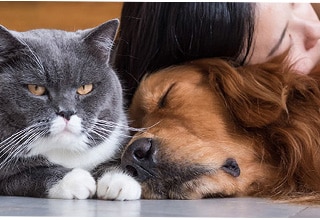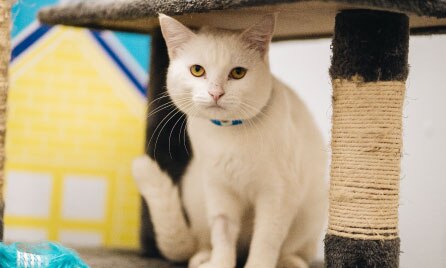- text
-
† Offer available to new Everyday Pet Insurance policyholders, and is limited to 1 membership per eligible policy. The free membership offer (valued at $199p.a) is from the date of your policy commencement, provided your Everyday Pet Insurance policy remains active. You are not eligible to redeem the free membership subscription for cash or credit. VetAssist is a separate subscription based service to the Everyday Pet Insurance product, and is provided independently by Everyday Insurance third party service provider, VetChat Services Pty Ltd (VetChat). Click here for full VetAssist Service terms and conditions. Everyday Insurance reserves the right to vary or remove this offer at any time and will provide reasonable notice of any such changes.
How to introduce a new cat or dog to the family home
Welcoming a new cat or dog into the family is an exciting time for everyone. Dogs and cats can both be very territorial by nature and a new environment can be a big step for a young puppy or kitten, or even an older animal. However, there are a few things you can do to make the transition as smooth as possible and enjoyable for the entire family.
Be prepared
Have you cat- and dog- proofed the house? Preparing for the arrival of a new pet depends entirely on your situation and circumstances, but always comes down to common sense and putting safety first. Remove any and all poisons, traps and toxic plants from in and around the house, and make sure screens and house fixtures like windows and doors are securely fastened and in good working order.
It’s their house too now
Make sure you let your new puppy or kitten know that this is their home too. Give them an area just for them and their ‘stuff’. You have months to impose boundaries on your new pet, but the first few days and weeks are for bonding and making sure he or she feels comfortable and ‘at home’ in their new surroundings. At the very least, you should provide them with a bed, feeding and drinking bowls, and a chew toy or two. And make sure they know where these things are kept.
Go see the world
Cats and dogs alike need to get accustomed to their surroundings and familiar with the scents, sights, and sounds around them, and that means allowing them time to explore the yard and immediate environment outside.
Take your puppy outside and allow him time to explore and play – be sure to close any gates and fences or keep your dog on a lead until you feel comfortable that he won’t get himself hurt. A new kitten is probably too small to be allowed outside unattended, but older cat owners will attest to the fact that there isn’t really a choice in this matter – in fact I’d be surprised if your cat hasn’t already snuck off to explore.
Lavish them with attention
This is probably the easiest and most enjoyable part of the process, but is worth mentioning here because it can have a profound impact on how well your dog or cat deals with the new environment. This is especially the case in situations where there is already another pet in the home. In these circumstances, we strongly recommend that you give equal attention to all animals so that no jealousy or sense of favouritism is created.
Bonus tips to help your new cat or dog settle
Sometimes all the preparation in the world cannot make the transition to a new home any easier because some animals are simply too nervous or anxious for these processes to be effective. Here are a few ideas to help calm your kitty or pacify your pooch:
Leave them in their crate with the door open, and leave that crate in the middle of the room. This is especially effective if there are already animals or small children and toddlers in the house as this tactic gives both parties a chance to ‘check each other out’ in their own time. Keeping your dog or cat in their crate (that they can freely see out of) allows them to scrutinise their environment whilst feeling secure in their ‘basket’. Give it an hour or two and watch them slowly step out into their new world and begin to explore.
Never force your new dog or cat to do anything they don’t want to do. Handle them quietly and gently, and unless they are in danger of hurting themselves or others, let them explore at their own pace. Pretty soon they will feel secure enough and the fun times can begin!
Related articles.
- text
-
Everyday Pet Insurance policies entered into for the first time prior to 17 July 2023 and subsequent renewals of those policies are issued by The Hollard Insurance Company Pty Ltd ABN 78 090 584 473, AFSL 241436 (Hollard), arranged and administered by PetSure (Australia) Pty Ltd ABN 95 075 949 923, AFSL 420183 (PetSure) and promoted and distributed by Hollard’s Authorised Representative (AR) Woolworths Group Limited ABN 88 000 014 675, AR 245476 (Woolworths). Everyday Pet Insurance policies entered into for the first time on or after 17 July 2023 and subsequent renewals of those policies are issued by PetSure and promoted and distributed by PetSure’s AR, Woolworths. Any advice provided is general only and does not take into account your individual objectives, financial situation or needs. Please consider the Product Disclosure Statement (PDS) to ensure this product meets your needs before purchasing, or choosing to continue with the product. PDS and Target Market Determination available at insurance.everyday.com.au/pet-insurance.




